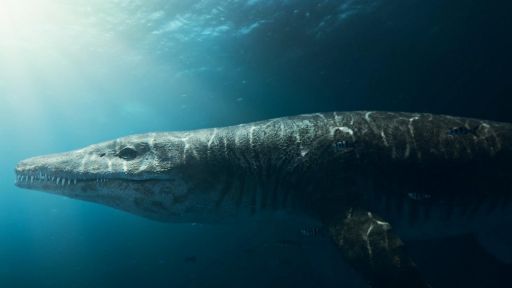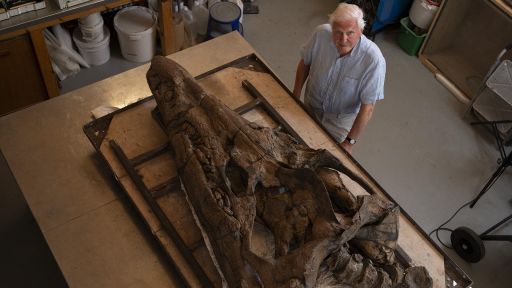Sir David Attenborough investigates the discovery of a lifetime: the giant skull of a prehistoric sea monster, known as a Pliosaur – the Tyrannosaurus Rex of the seas.
Features
- [David] Paleobiologist Dr. Andre Rowe is a world leading expert in 3D visualization of fossils.
- First thoughts, this thing is absolutely massive, and I will also add that the level of preservation is amazing.
There's this common misconception that fossilization is just this really common thing and we get these complete skulls all the time, and that's sadly not the case.
This is actually a one in a million, might be one in a billion type specimen here.
- [David] Using the latest technology, Andre is carrying out the world's first surface scan of pliosaur's skull.
- So right now we're capturing basically hundreds of thousands of images all at once.
It's essentially putting together a big 3D jigsaw puzzle.
The end result is a really nice looking 3D model, which we can use for biomechanics, studying the anatomy.
I think we'll be able to unlock a lot of mysteries about what these sea monsters were doing, and I'm really excited to see where it takes us.
- [David] Once the scan has been finalized, I meet Andre at the University of Bristol to discuss his findings.
Has he seen anything in the skull structure that shows our sea monster had the power of a truly deadly predator?
- There's some massive openings back here along the jawline.
- [David] Yeah.
- [Andre] And that's good for muscles to attach and bulge out.
- There'd be a muscle goat running through there?
- Yes, we have the pterygoid muscle group, which is in a lot of big dinosaurs and it's integral to having a really strong bite.
And we've hypothesized that this particular pliosaur, kind of the apex predator in the Jurassic ecosystems that was living in.
- In the sea.
- Yes.
- Does this skull give you any information about what animals prey might have been?
- The animal would've been so massive that I think it would've been able to prey effectively on anything that was unfortunate enough to be in its space.
A popular hypothesis is that these animals were actually ripping off the limbs of other animals that disabled them from swimming away and then kind of going in for a kill.
- So this is really a top predator?
- Yes, I have very little doubt just judging from how massive that skull is.
I don't see what could have possibly hurt it.
- How would it compare with T-Rex?
- I Imagine it would be pretty comparable and they were kind of both the respective apex predators in their ecosystems.
So I have no doubt that this was sort of like an underwater T-Rex, if you will.
- Okay, let me ask you the the million dollar question.
In a battle between T-Rex and our pliosaur, who's gonna win?
- As much as it pains me and brings a tear to my eye to admit it, I think that my T-Rex is going to lose this fight.
And then millions of years later, American paleontologist will envision this scene and break down into tears.
(David Attenborough laughs) (water rushing)


